Weekly birding round-up: 11 - 17 July 2025
We said in the opening remarks of last week’s round up that the seawatching hadn’t yet caught fire and this week, while the full conflagration was still not upon us, we certainly had some bright sparks rise from the smouldering embers. Any week that features a second for Britain seabird must surely count as a success.
Bird of the week by a country mile has to be the Soft-plumaged Petrel tracked along the Cornish coast in the evening of 13th – seen initially from Coverack, then Lizard Point and, later on, at Porthgwarra.
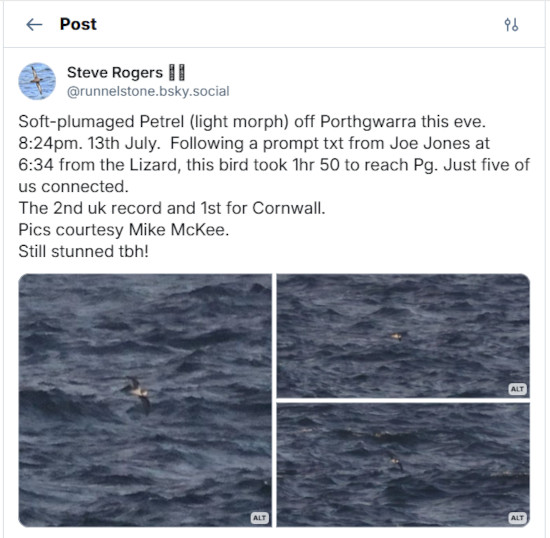
While other Pterodroma are more or less an annual certainty these days in British and Irish waters, Soft-plumaged Petrel remains a Holy Grail species, limited to just the one confimed record that, with some striking similarities to this week’s bird, was also tracked along a stretch of coastline over the course of a few hours – being found initially off Flamborough (East Yorkshire) on 1st July 2021, and seen as the day elapsed from various points northwards until it was last noted from Stag Rocks (Northumberland) in the early evening. See the BOU article regarding its addition to the British List here
That was Britain’s first – Britain’s second, this week, wasn’t seen over quite such a prolonged period, but it gives plenty of hope that another sighting won’t be too far away in the future. No doubt the Scilly pelagic teams will be hitting the water with renewed optimism in the coming weeks.
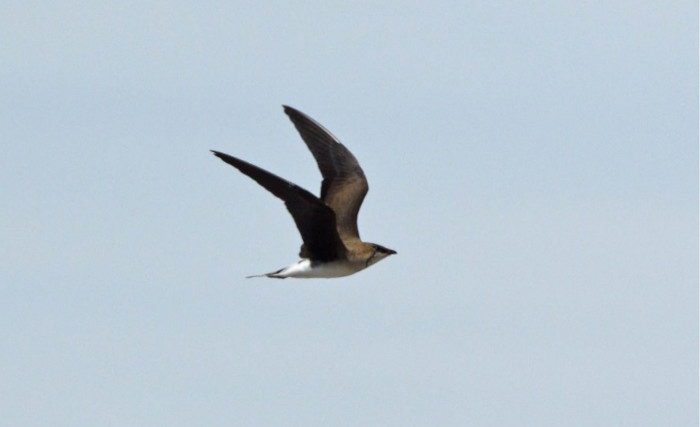
After a stay that’s extended for weeks, the Black-winged Pratincole in Shetland was showing signs of increasingly itchy feet in the past fortnight and, though it began the present week still in the Loch of Spiggie area on 11th-12th, it seemed to have done a bunk on 13th.
Presumably one and the same bird arrived on North Uist (Western Isles) on 15th, representing only the second record for the county, following the first on Lewis on 2nd-6th August 2012. A good bird for local birders, then.

The weekly haul of Wilson’s Petrel was significantly up this past week, with an overall tally of some 160 birds recorded. The Scilly pelagics were doing a lot of the heavy lifting in this regard, with a highest daily count of 51 individuals noted on 17th. Land-based observers in Ireland were doing well too, with 12 birds seen from Bridges of Ross (Co.Clare) on 15th; while nine from Porthgwarra (Cornwall) on 16th were notable.

Leach’s Petrel were trapped and ringed on North Ronaldsay (Orkney) on 13th, 15th, and 16th; and another was noted from Bridges of Ross (Co.Clare) on 15th.
Bridges of Ross (Co.Clare) gave us another Barolo Shearwater on 14th…
…while aficionados of a the subtleties of large shearwaters got their just rewards with the first Scopoli’s Shearwater of the year seen off Porthgwarra (Cornwall) on 14th also.
Numbers of Cory’s Shearwater picked up, with around 300 birds logged during the week. The largest single site count was 66 seen from Galley Head (Co.Cork) on 14th.

Great Shearwater on the other hand were still barely with us yet – on 15th one was seen from Porthgwarra (Cornwall), two from the Scilly pelagic, and three off Bridges of Ross (Co.Clare); and a singleton was seen from the Scilly pelagic of 16th.
Numbers of Balearic Shearwater remained fairly modest, with around 90 birds noted nationwide during the week, and a peak count of 45 from Start Point (Devon) on 16th.
A handful of Pomarine Skua were seen in recent days – one north past Whitburn CP (Co.Durham) on 12th; two off St Ives (Cornwall) on 13th; one seen at Arbroath (Angus) on 13th and 17th; one seen from Bridges of Ross (Co.Clare) on 15th; and an individual off Porthgwarra (Cornwall) on 16th. A single Long-tailed Skua was seen at Brandon Point (Co.Kerry) on 15th.
Keeping it interesting for long-legged beasties this week, Night Heron were noted at several sites – in Norfolk at Cley NWT and latterly near Stiffkey on 12th still; at Marden Quarry (Northumberland) on 14th-17th; at Grimley (Worcestershire) on 15th-17th; at Minsmere RSPB (Suffolk) on 16th; on 17th at Rye Meads RSPB (Hertfordshire); and heard over Kendal (Cumbria) late in the evening of 12th.
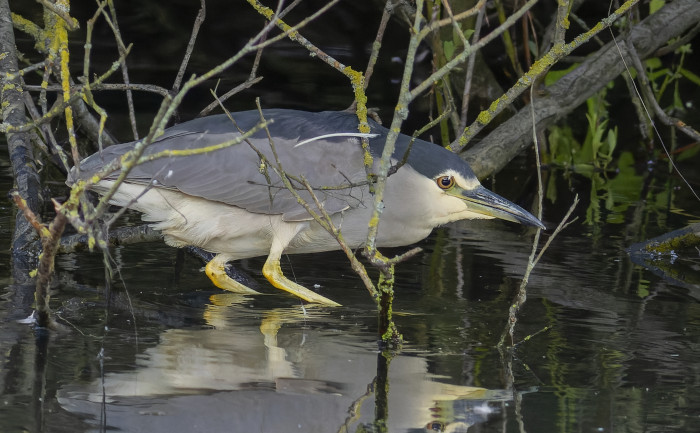
A Purple Heron appeared at Little Sea on Studland (Dorset) on 14th-17th.
Many of the regular recent cohort of Glossy Ibis continued to be seen this past week. Settled birds remained at Deeping Lakes LWT (Lincolnshire) on 11th-17th; at Otmoor RSPB (Oxfordshire) on 12th-17th; at Misson (Nottinghamshire) on 11th-16th; at Breydon Water (Norfolk) on 11th; on Sanday (Orkney) again on 13th; and at Lough Atalia (Co.Galway) on 11th-13th still. Another was noted at Went Ings (East Yorkshire) on 14th.
Seaduck continued to represent the most interesting side of the weekly quackers, with the immature drake White-winged Scoter still at Musselburgh Lagoons (Lothian) area on 11th-17th, and off St Cyrus (Aberdeenshire) again on 13th.
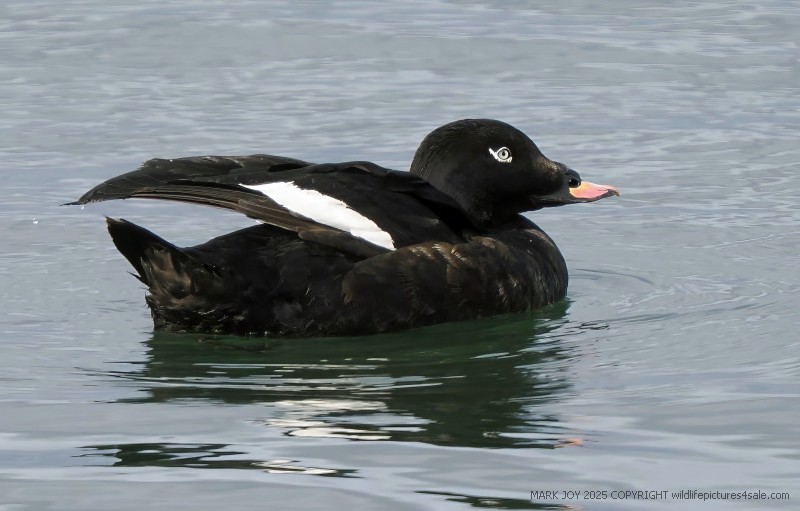
The drake Surf Scoter remained at Musselburgh Lagoons (Lothian) on 11th-17th.
In Greater Manchester the Lesser Scaup remained at Pennington Flash CP on 11th-12th and Audenshaw Reservoirs on 14th-17th.
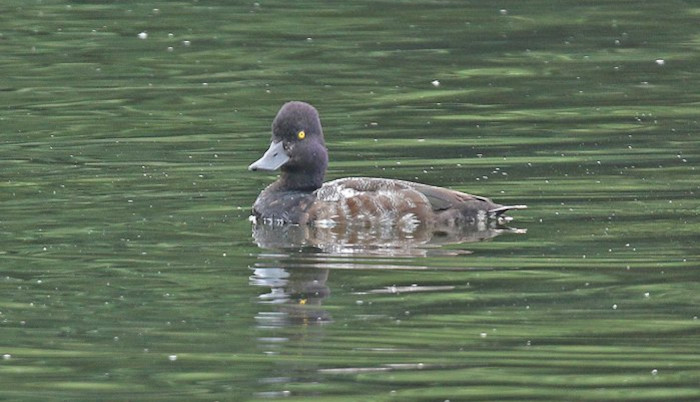
The week was a busyish one for Ferruginous Duck - the drake remained at Draycote Water (Warwickshire) on 11th-17th, and the female at Shawell (Leicestershire) on 11th; while on 13th sightings of a drake in Cambridgeshire came from Colne Fen GPs and Earith GPs, and a female at Stanford Reservoir (Northamptonshire / Leicestershire).
Finally, marking a new chapter in this spring / summer’s Cinnamon Teal story, an eclipse drake was seen on 15th at East Tilbury (Essex).
Away from the Scottish islands, the best of the week’s waders was the omnipresent Western Sandpiper, still to be seen at Maidens (Ayrshire) on 11th-16th.

A decent scatter of White-rumped Sandpiper sightings did much to enliven proceedings – birds being noted at Ballycotton (Co.Cork) still on 11th and Bann Estuary (Co.Derry) still on 12th; on Ythan Estuary (Aberdeenshire) on 14th; and at Musselburgh Lagoons (Lothian) on 15th-16th.
An adult Pacific Golden Plover brightened up Warham Greens (Norfolk) in the evening of 16th. Either this species or an American Golden Plover was present in the morning of 17th at Burgh Castle.
Finally, in Lancashire & North Merseyside the Lesser Yellowlegs remained at Leighton Moss RSPB on 11th-17th, while the recent bird in Hampshire was again reported from Pennington Marshes on 13th.
Kent continued to retain its regular adult Bonaparte’s Gull this week at Oare Marshes KWT on 11th-17th; while another probable adult was lingering in Aberdeenshire near Inverallochy on 13th-15th.

An adult Laughing Gull was seen heading past Dawlish Warren NNR (Devon) on 13th. A first-summer bird was found on 17th in Co.Kerry at Trabeg.
Our only white-winger this week was a report of a Glaucous Gull on 17th on Arran (Ayrshire).
In Co.Dublin the Least Tern remained near Portrane on 17th.
The American Black Tern meanwhile was again noted on Inner Farne (Northumberland) on 12th.

Last but never least, a Caspian Tern was seen in Northumberland at East Chevington NWT on 14th-15th.
Quiet times again this week on the raptor front. A Black Kite was seen in Cornwall near Sennen Cove on 14th… and a female Montagu’s Harrier at Antrim Hills (Co.Antrim) on 11th.
Onwards we go into the peacefulness that’s the weekly passerines et al at this time of year. We start with a handful of Bee-eater - one at Flamborough (East Yorkshire) on 11th, two over Boswedden (Cornwall) on 12th, and one heard only on 16th at Bempton Cliffs RSPB (East Yorkshire).
Shetland’s northern isles harboured a couple of female Red-backed Shrike in recent days – individuals seen on Fetlar and Unst on 14th. Another bird was seen on Mainland at Sullom Voe on 16th.
A Golden Oriole was heard in song at Willington (Bedfordshire) on 11th.
Up on Fair Isle (Shetland), the male Eastern Subalpine Warbler remained present on the island on 14th-15th.
The singing male white-spotted Bluethroat remained on station in Gloucestershire at Slimbridge WWT on 11th-14th.
A couple of Serin were logged this week – one in North Yorkshire over Sutton Bank on 11th; and another singing bird reported in Cornwall at Goldsithney on 15th.
Back in Shetland the recent Black-headed Bunting remained on Foula on 11th.
Final belated news came in this week of a Slate-coloured Junco seen in an Ely (Cambridgeshire) garden in the evening of 9th. Alas, not seen there subsequently.
We’ll start the overseas news once again fairly close to home in France, where a Cape Gull at Trilbardou on 12th was a timely reminder to keep checking the large gulls in the coming weeks. A dark morph Western Reef Heron was seen on 16th at Decize. Elsewhere in France the Bridled Tern was still at Ile aux Moutons on 14th, and the Elegant Tern at Polder de Sebastopol on 12th.
In the Netherlands, the Pygmy Cormorant remained at Natuurpark Lelystad on 12th.
Italy held onto the Pacific Swift in Cornaiano on 11th. Looks increasingly like it’s not happening in Shetland this year…
Creeping ever closer to us, however, the recent Dalmatian Pelican continued its Scandinavian tour this week, being seen in Norway at Olmassastoskjeran on 11th.
Up in Iceland, the recent Oriental Turtle Dove was still present at Olafsvik on 13th.
Heading much further afield, a Bateleur was seen in Israel at Ramat Shiryon on 13th.
And finally, in Egypt this week, three Crimson-rumped Waxbill and two Village Weaver were present at Abu Simbel on 14th.
While it will come as little surprise to any of us if there’s another decent seabird found in the coming week – none of the Fea's/Zino's/Desertas Petrel options would be entirely out of leftfield from here on – it’s still relatively early days in that regard.
A decent wader still feels like a more likely option at this juncture.
The coming week offers some historic suggestions as to what we might dare to dream of. Both Pacific Golden Plover and Broad-billed Sandpiper have scaled the dizzy heights of double figures, with 14 and 12 records apiece respectively.
Sand plovers remain an outside possibility, as do early moving peeps – the coming week offers one record of Least Sandpiper, back in 1995, and two of Red-necked Stint - at Blacktoft Sands (East Yorkshire) on 22nd-29th July 1986, and Pool of Virkie (Shetland) on 18th-21st July 2000. These being a significant percentage of all British records of the latter species, the coming week has some chops in their regard.
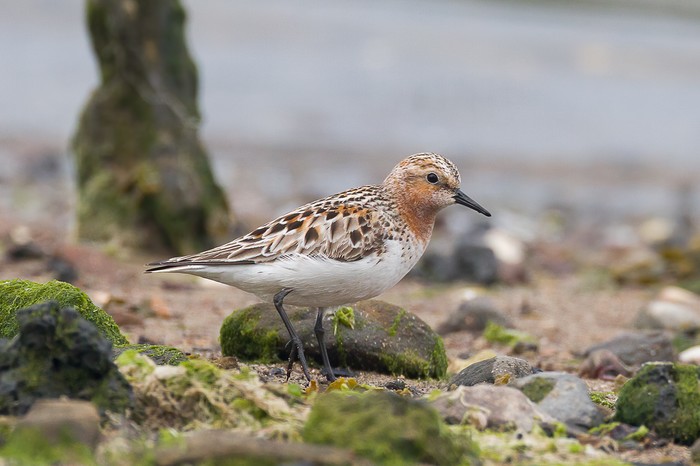
Jon Dunn
18 July 2025
Many thanks to all this week's contributors for your photos and videos
Share

















